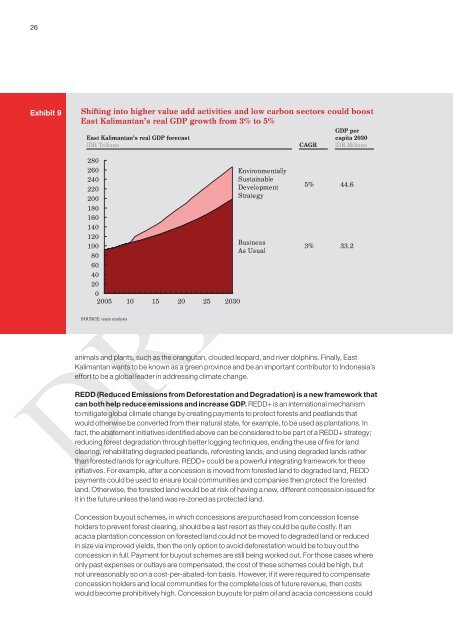East Kalimantan Environmentally Sustainable Development Strategy
East Kalimantan Environmentally Sustainable Development Strategy
East Kalimantan Environmentally Sustainable Development Strategy
Create successful ePaper yourself
Turn your PDF publications into a flip-book with our unique Google optimized e-Paper software.
26<br />
Exhibit 9<br />
Shifting into higher value add activities and low carbon sectors could boost<br />
<strong>East</strong> <strong>Kalimantan</strong>’s real GDP growth from 3% to 5%<br />
<strong>East</strong> <strong>Kalimantan</strong>’s real GDP forecast<br />
IDR Trillions<br />
280<br />
260<br />
240<br />
220<br />
200<br />
180<br />
160<br />
140<br />
120<br />
100<br />
80<br />
60<br />
40<br />
20<br />
0<br />
2005<br />
SOURCE: team analysis<br />
10<br />
15<br />
20<br />
25<br />
2030<br />
<strong>Environmentally</strong><br />
<strong>Sustainable</strong><br />
<strong>Development</strong><br />
<strong>Strategy</strong><br />
Business<br />
As Usual<br />
CAGR<br />
GDP per<br />
capita 2030<br />
IDR Millions<br />
animals and plants, such as the orangutan, clouded leopard, and river dolphins. Finally, <strong>East</strong><br />
<strong>Kalimantan</strong> wants to be known as a green province and be an important contributor to Indonesia’s<br />
effort to be a global leader in addressing climate change.<br />
REDD (Reduced Emissions from Deforestation and Degradation) is a new framework that<br />
can both help reduce emissions and increase GDP. REDD+ is an international mechanism<br />
to mitigate global climate change by creating payments to protect forests and peatlands that<br />
would otherwise be converted from their natural state, for example, to be used as plantations. In<br />
fact, the abatement initiatives identified above can be considered to be part of a REDD+ strategy;<br />
reducing forest degradation through better logging techniques, ending the use of fire for land<br />
clearing, rehabilitating degraded peatlands, reforesting lands, and using degraded lands rather<br />
than forested lands for agriculture. REDD+ could be a powerful integrating framework for these<br />
initiatives. For example, after a concession is moved from forested land to degraded land, REDD<br />
payments could be used to ensure local communities and companies then protect the forested<br />
land. Otherwise, the forested land would be at risk of having a new, different concession issued for<br />
it in the future unless the land was re-zoned as protected land.<br />
DRAFT<br />
5%<br />
3%<br />
44.6<br />
33.2<br />
Concession buyout schemes, in which concessions are purchased from concession license<br />
holders to prevent forest clearing, should be a last resort as they could be quite costly. If an<br />
acacia plantation concession on forested land could not be moved to degraded land or reduced<br />
in size via improved yields, then the only option to avoid deforestation would be to buy out the<br />
concession in full. Payment for buyout schemes are still being worked out. For those cases where<br />
only past expenses or outlays are compensated, the cost of these schemes could be high, but<br />
not unreasonably so on a cost-per-abated-ton basis. However, if it were required to compensate<br />
concession holders and local communities for the complete loss of future revenue, then costs<br />
would become prohibitively high. Concession buyouts for palm oil and acacia concessions could

















